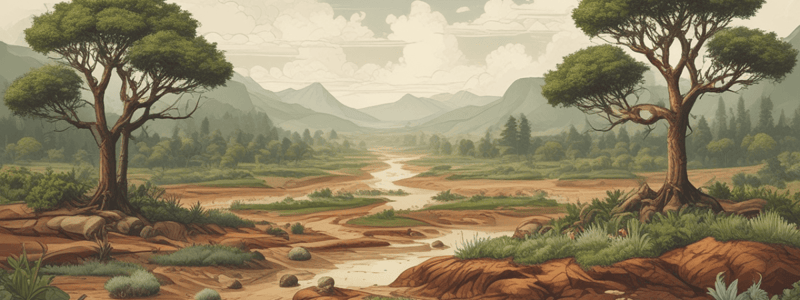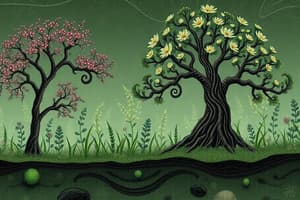Podcast
Questions and Answers
What is characteristic of columnar soil aggregates?
What is characteristic of columnar soil aggregates?
Why is studying soil important for humans?
Why is studying soil important for humans?
What is an additional use of soil besides agriculture?
What is an additional use of soil besides agriculture?
Why is understanding the soil beneath a construction site important?
Why is understanding the soil beneath a construction site important?
Signup and view all the answers
What type of soil is commonly used to build houses?
What type of soil is commonly used to build houses?
Signup and view all the answers
Why is clay soil used to build houses?
Why is clay soil used to build houses?
Signup and view all the answers
What is a characteristic of platy soil?
What is a characteristic of platy soil?
Signup and view all the answers
Why is soil crucial for a macro-level ecosystem like a forest?
Why is soil crucial for a macro-level ecosystem like a forest?
Signup and view all the answers
What is an importance of soil in agriculture?
What is an importance of soil in agriculture?
Signup and view all the answers
What is a use of soil as a building material?
What is a use of soil as a building material?
Signup and view all the answers
Study Notes
What is Soil?
- Soil is a medium that consists of a mixture of sediment, minerals, organic matter, air, gases, liquids, and organisms that provide the fundamental ecosystem and essentials for plant life and all life.
Functions of Soil
- Soil provides space and medium for plants to grow, with their roots needing soil to live and thrive.
- Soil provides water storage and purification, with water soaking into the soil and being filtered as it flows through.
- Soil provides a home for many organisms, especially microorganisms.
- Soil takes part in all major biogeochemical cycles, such as the phosphorous cycle, nitrogen cycle, and carbon cycle.
Soil Composition
- Soil composition varies depending on the region and can have different gas content, including carbon dioxide or methane.
- Microorganisms perform cellular respiration and release carbon dioxide into the soil and atmosphere.
- Decomposing organic matter in soil produces carbon dioxide and methane.
- Plants have different biological processes that take nitrogen out of the soil or release it back into the soil.
Soil Structure and Development
- Soil develops and accumulates from its basic components of organic matter, sediments or minerals, water, and gases through multiple processes.
- Sediment weathering is the first step in soil development, with rocks being broken down into smaller pieces through physical or chemical processes.
- Sediment erosion or transport allows the sediment to be deposited and accumulated in a new location.
- Organic matter introduction through pioneer species such as lichens and moss helps to further break down bare rock into looser sediments.
- Organic matter decomposition introduces gases to the sediments, making it more nutritious for plant growth.
Types of Soil
- There are four major types of soil: sand, silt, clay, and loam.
- Each type of soil provides different circumstances and microclimates, regarding water content and permeability, and aeration.
- Sand is the coarsest and loosest of soil classifications, with particles visible to the naked eye, providing easy drainage but being nutrient-poor.
- Silt is finer than sand, holding onto water more and longer, making it more nutritious for plants, but less common than sand.
- Clay is very fine-grained silt, holding onto water well, but lacking drainage, making it unsuitable for plant growth.
- Loam is a combination of sand, silt, and clay, providing the best of both worlds for plant life.
Soil Profile and Horizons
- A soil profile consists of many layers of sediments beneath a top layer of soil, each layer being a different soil horizon.
- Top layers of soil might have a different sediment matrix than the soil horizon beneath it.
- Soil horizons can be compacted layers of sands, silts, or clays before reaching bedrock.
Uses of Soil
- Soil is essential for agriculture and food production, with farmers trying to maintain good soil conditions for their crops.
- Soil is also used in fiber production, building construction, and as an ingredient in concrete.
- Understanding soil, its micro-ecosystems, and life cycles is important for maintaining proper soil conditions for future generations.
Studying That Suits You
Use AI to generate personalized quizzes and flashcards to suit your learning preferences.
Description
Soil is a vital part of an ecosystem, providing space and medium for plants to grow, storing and purifying water, and supporting life.




